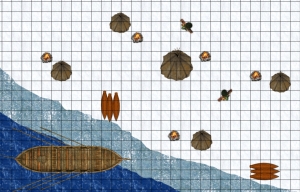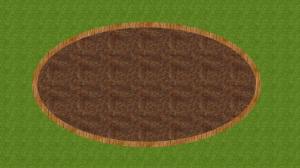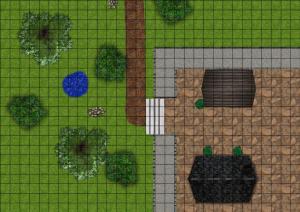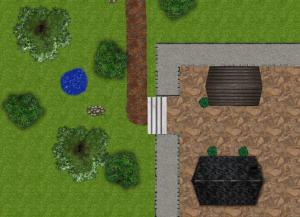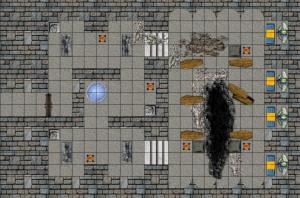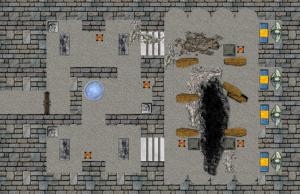A bittersweet night, as this was the last session of Dark Legacy of Evard that I’ll be running. Of course, that’s because I’ll be in Indianapolis next week for Gen Con, so I guess I’ll survive!
At our 5:00 table we had a bit of a problem; only three players showed up. We’ve had as many as 14 in the past, and the last two weeks had 8 and 7. I waited until 5:10, and when no more players showed up I decided to run with just the three players. We had a defender and two strikers.
Scaling is a little tricky when you have so few characters and their levels are a bit uneven (one at level 1, one at 2 and one at 3). The encounter originally called for an evil wizard, a shadow bolter and four dusk beasts. I decided to take it down to 2 dusk beasts and go from there.
The encounter began with the party trying to figure out how to get into the spooky library where the wizard Nathaire (possessed by the spirit of the evil wizard Vontarin) was apparently holed up. They decided to try to sneak close to the front door and then quietly pick the lock. They failed. They made noise. And eventually they got the door open, whereupon I granted a surprise round to the two-headed shadowy dusk beast that had been sent to the door to investigate. Chomp.
The knight charged bravely into the library and started handling the dusk beast. The vampire and the assassin tiptoed in as well. Nathaire taunted them from upstairs, telling them that he had no desire to destroy them, but when they kept fighting his minions the evil wizard started blasting them with shadowy tendrils.
Eventually the shadow bolter made his presence known. The vampire and assassin stayed downstairs to deal with him while the knight climbed the stairs to go after the wizard… only to find that the wizard had another dusk beast standing guard upstairs.
The vampire was knocked unconscious by the bolter, but luckily got a 20 on his second death save. The knight, meanwhile, was in deep trouble with the wizard after taking out the second dusk beast. He started dying, taking ongoing enervation damage.
At this point it seemed quite likely that I would kill off the party, so I took the knight’s player up on his earlier suggestion of letting him run a second PC – a healer. The reinforcements arrived, and the party got back on its feet and finished off the dark mage, trapping his soul in a purple orb.
At 7:00 I had a table of four. Two were regulars from the 7:00 group from the past couple of weeks (including a fellow player in my Pathfinder group). One was my lovely wife (yay!). And the fourth was a brand-new D&D player who I’d met via EN World when he reached out to ask some general questions about the game and mentioned in his post that he lived near a store called Enchanted Grounds. I exchanged some messages with him, and he showed up to play!
This group had two defenders and two controllers – once again, no healer. They were a pair of 3rd level characters and a pair of 1st level characters. I decided to use the same scaling as I had for the earlier game (two dusk beasts instead of four).
The encounter began when the vryloka paladin walked up to the library and knocked on the door. When the voice on the other side (a shadow bolter) asked who was there, the paladin lied and said he was one of the people Vontarin had commanded to create undead in the crypts and he needed to talk to the wizard. With a great Bluff check, the shadow bolter opened the door and I allowed the paladin a free surprise round attack.
My wife’s binder opened the combat by dropping a zone of difficult terrain right inside the door – a mixed blessing that worked out okay. The paladins led the way into the library, and the new player’s paladin was knocked to the ground by a readied bite from a dusk beast. Nathaire/Vontarin exchanged taunts with the binder and the mage, which was a ton of fun; I loved role-playing the evil wizard.
The party took care of the dusk beast and shadow bolter downstairs without getting beat up too badly, and the binder and mage started zapping Vontarin from afar. The paladins started fighting through the upstairs dusk beast on the way to the dark mage. When the party’s eladrin mage teleported into the balcony behind Vontarin, the evil wizard closed to melee with the paladins.
The new player’s paladin was low on hit points when the bloodied dark wizard reached out to touch him with despair. He hit. The attack brought the paladin to dangerously negative hit points… and the slide effect took him off the balcony, whereupon the falling damage finished him off. In the very next round, the surviving PCs killed off the evil mage.
The new player’s character died heroically and rather cinematically (tossed off a balcony by a big bad guy), and he had an absolute blast with the experience. I stayed afterward to talk to him about D&D4e and how to get into the game. He ended up buying a copy of Heroes of the Forgotten Kingdoms (he loved the idea of the dual-weapon wielding Scout ranger) and I suggested D&D Insider if he decides he’s going to stick with the game. He’s a really great guy, and I hope to see him again at future games.
Thus ends my experience with Dark Legacy of Evard. I’m bummed that I won’t get to run the final session, but that’s okay. I’ll be jumping into the next season of Encounters for a few weeks before my Wednesday night bowling league begins at the end of August, and I’m looking forward to it. I love the way Encounters lets me bring new players into the game. It’s been a lot of fun.




